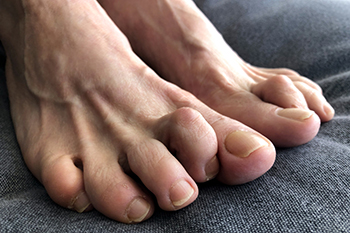
Hammertoe is a foot deformity characterized by an abnormal bending of the toe joints, causing the affected toe to resemble a hammer or claw. This condition typically affects the second, third, or fourth toes. It results from an imbalance in the muscles, tendons, and ligaments that control toe movement. Tightening of the ligaments and tendons, often due to wearing ill-fitting shoes with narrow toe boxes or high heels, can force the toes into a bent position over time. Additionally, genetic predisposition, foot structure abnormalities, and underlying conditions like arthritis or nerve damage can contribute to the development of hammertoes. As the condition progresses, individuals may experience pain, discomfort, corns, or calluses on the affected toes, making it difficult to wear shoes comfortably. Early intervention through proper footwear, toe exercises, orthotic devices, and, in severe cases, surgical correction can help alleviate symptoms and prevent complications associated with hammertoe. If you have hammertoe, it is suggested that you seek guidance from a podiatrist for an appropriate diagnosis and management of this condition.
Hammertoes can be a painful condition to live with. For more information, contact Glenn Aufseeser, DPM of Lakewood Foot and Ankle Specialists. Our doctor will answer any of your foot- and ankle-related questions.
Hammertoe
Hammertoe is a foot deformity that occurs due to an imbalance in the muscles, tendons, or ligaments that normally hold the toe straight. It can be caused by the type of shoes you wear, your foot structure, trauma, and certain disease processes.
Symptoms
- Painful and/or difficult toe movement
- Swelling
- Joint stiffness
- Calluses/Corns
- Physical deformity
Risk Factors
- Age – The risk of hammertoe increases with age
- Sex – Women are more likely to have hammertoe compared to men
- Toe Length – You are more likely to develop hammertoe if your second toe is longer than your big toe
- Certain Diseases – Arthritis and diabetes may make you more likely to develop hammertoe
Treatment
If you have hammertoe, you should change into a more comfortable shoe that provides enough room for your toes. Exercises such as picking up marbles may strengthen and stretch your toe muscles. Nevertheless, it is important to seek assistance from a podiatrist in order to determine the severity of your hammertoe and see which treatment option will work best for you.
If you have any questions, please feel free to contact our offices located in Lakewood and Manchester Township, NJ . We offer the newest diagnostic and treatment technologies for all your foot care needs.
